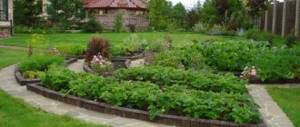Selecting a location
The ideal area for growing a lawn is selected as follows:
- English lawns are characterized by open terrain. In this case, the lawn should grow without shade or wind. The lawn green area in the garden should be removed from the house;
- The grass in the dacha does not tolerate proximity to trees. Powerful rhizomes will take beneficial components from the soil, and the grass will be left with meager nutrition. At the same time, the shade of the garden trees will prevent the grass from becoming lush and bright green. Garden trees can be given a radical pruning, but this is not at all a rational design for a lawn;
- grass should not grow in excessive dampness. To sow a lawn, the low-lying area of the garden must be equipped with proper drainage;
- ideal grass appears only on a flat area. Bumpy soil areas are contraindicated for rolled lawns. It is better to dig up the area in the garden in advance so that there is no stagnant water left. And also so that processing the grass does not become a burdensome event;
- It is recommended to sow a lawn at the dacha with your own hands where the soil with plants will not be constantly used. Walking terrain not only causes compaction of the soil, but also the death of the grass in the garden. In the case of a small plot in the country, it is better to prepare a laying of tile paths on the lawn so that the grass remains intact.
Soil preparation
To sow a smooth lawn, it is necessary to prepare the selected turf in advance. The process may take a week, but they will be acquitted later.
Experienced gardeners offer beginners arranging a clearing according to the following step-by-step instructions:
- To purchase the right fertilizer, it is worth identifying the structure of the turf in advance. The soil composition of the garden is also important. These indicators are revealed by special testers from department stores for the garden. When tests show excessive acidity in the soil, it is extinguished with chalk or lime. For clay areas of the garden, purchase chernozem mixtures or manure fertilizer;
- If you seed your lawn with a certain type of grass, the soil will need additional fertilizer. They are planted in the dug up soil of the garden. Mineral supplements may vary seasonally. To sow a lawn in the spring, nitrogen substances are purchased, and for autumn planting of grass it is preferable to use phosphorus compounds. If at the same time there is a lot of fatty soil left, then the previous minerals need to be minimized;
- You can even out the useful components using a rake yourself. And then saturate the soil under the rolled lawn with moisture;
- After preparing the land, the area is carefully leveled. At the same time, all the holes in the garden are covered with earth, then passed over them with a specialized roller;
- After installation, the area is left untouched for several days. The ground is checked for weeds. And remove unwanted herbs that remain. After leaving, this area of the garden is compacted again.
Landscape design price
| Planting flowers and shrubs | Unit | Price, rub) |
| Creation of flower beds and decorative compositions | 1 sq.m. | 1350 |
| Planting shrubs | 1 PC. | 270 |
| Construction of water structures | ||
| Wells | according to the project | negotiable |
| Decorative ponds | 1 sq.m. | from 6000 |
| Creation of small architectural forms | according to the project | negotiable |
| Tree planting | ||
| Deciduous | 3-5 m. | from 5900 |
| 4-6 m. | from 8100 | |
| from 6 m. | from 12300 | |
| Conifers | 3-5 m. | from 13900 |
| 4-6 m. | from 20850 | |
| from 6 m. | from 27600 | |
| The price for planting trees includes their packaging, transportation and planting | ||
| Caring for trees, bushes and flower beds | ||
| Treating trees against pests | 1 PC. | from 60 |
| Fertilizer treatment | 1 PC. | from 45 |
| Trimming tree branches | 1 PC. | from 400 |
| Lawn restoration | 1 sq.m. | from 100 |
| Landscape design | project | negotiable |
Landscape design is a large complex of activities that combines practical, aesthetic and creative components. The main objective of this type of activity is to create a harmonious appearance of the territory, taking into account the features of its topography, existing buildings, plants and reservoirs. The site should look natural, as if nature itself created it the way it will be. It cannot be said that all landscapes are initially beautiful, but the owner always has the opportunity to make his property more noble and aesthetically pleasing.
In landscape design, it is important to think through everything to the smallest detail. When putting the creative component of the planned project to the fore, we must not forget the practical part. The surrounding area of a country house or cottage, park area or garden should be convenient for use and maintenance, without causing worries to the owner.
When developing a site plan and drawing up a sketch of the project, the designer takes into account the following important conditions:
- Location of the territory relative to the cardinal directions;
- Terrain;
- Proximity to large bodies of water and forest belts;
- Availability and location of buildings and structures on site;
- The variety of plants, shrubs and flowers available on the site;
- Location of communications, irrigation and water supply systems.
Plants that are planned to be planted on the territory must be correctly grouped according to species. This will improve their survival rate and create a natural composition. It is important to practice moderation. Buildings, structures, plants, trees, shrubs, flower beds and flower beds, decorative elements such as paths, swings, verandas, as well as reservoirs of various sizes should correctly complement each other, creating a moderate and harmonious style of the site.
The process is complex and multifaceted; it is better to entrust it to a specialist. provides landscape design services and has an extensive list of successfully completed projects in its portfolio. The design project of your site will be carefully thought out to the smallest detail and implemented in the shortest possible time in compliance with all technical and technological standards. The creative component will be combined with a strict and serious approach. Designers will implement all your ideas by sharing their experience and knowledge. The territory will take on a more noble and neat appearance, uniting with natural harmony.
How and when to sow
How to make a lawn on fertile soil perfectly flat? First, the area should be properly seeded, and then create a beautiful design on the lawn.
Seed planting is carried out as follows:
- calculate the sown area to purchase the required volume of seeds. It is better to compact the seed planting to make the lawn thick;
- The seeds are planted evenly on the site. To do this, you need to carefully dig up the turf and select several zones. The same volume of seed must be added to each zone;
- manual application of seeds is dangerous due to unevenness. Therefore, the arrangement of the lawn is carried out first along the selected zones, and then across. Near pedestrian areas of the lawn, the seed volume should be increased;
- It is better to dig up and sow the dacha in the calm;
- Dry areas of the lawn require drip irrigation. It is important that watering does not wash away the seeds;
- Afterwards, it’s worth digging up the seed crops a little with a rake to protect them from birds;
- As a result, compact the sown areas and spray water on them after installation.
To determine the time of sowing a lawn in the garden, you need to evaluate its scale. In winter, lawn marking and light cleaning are performed. And from the beginning of spring it is necessary to dig up the fertile turf for planting a beautiful lawn. Before the first winter, it is recommended to mow the lawn and remove weeds several times. However, mowing in the garden is carried out if the height of the plants on the lawn is from 11 cm.
Care
A guide on how to make your lawn with plants neat and extremely green within a year:
- cutting of plants is carried out so that after treatment the height of the stem does not decrease by more than a third;
- the initial cutting is carried out if the plants on the lawn are at least 10 cm high. You need to cut no more than 1 cm;
- subsequent cuttings contribute to the growth of lawns;
- Do not trample the lawn in the garden or overload it with processing;
- watering of the roll garden is carried out using the spray method to a depth of 7 cm;
- do not disturb the lawn cover in winter. However, they monitor the excess of snow masses;
- In spring, they practice earth piercing in the garden to prevent water stagnation. After the soil has dried, the lawn in the garden is freed from weeds and the seeds are sown;
- watering and mowing are valuable for summer garden care;
- In the fall, fertilizing mixtures are carefully sprayed onto the lawn in the garden.
Which lawn is better?
You can sow the lawn in the garden with herbs or special mixtures that are sold in specialized stores. From ornamental lawn grasses you can choose:
Reigrass is a fast-growing grass that forms a beautiful lawn in the first year. With its help, you can straighten lawns that have bald spots. Rhegrass kills all weeds, so it is widely used for planting between trees in the garden. The cereal does not tolerate frosts below -12 degrees, which is why it can only be planted in southern regions with warm winters.
- Bentgrass is an unpretentious plant with a beautiful green color that grows quickly, forms a dense covering and tolerates low mowing.
- Timothy grass is a low-growing grass that grows up to 30 cm and is characterized by the rapid growth of dense rosettes, resistance to trampling and cold winters. It does not have much decorative value, so it is used only in private garden areas. Timothy is not suitable for parterre lawns.
- Fescue is an unpretentious, drought- and frost-resistant grass up to 25 cm high. It grows quickly and well even on poor soils, so it is used to create various lawn mixtures.
- Meadow bluegrass is a low-growing plant up to 20 cm high and has a powerful root system that quickly kills weeds. The grass recovers quickly, is not afraid of trampling and is heat-resistant. During the flowering period, spikelets rise above the greenery, as a result of which the height of the plant reaches more than 60 cm. To make the lawn beautiful, meadow bluegrass should be planted on soil rich in humus.
There are several types of lawns , each of which consists of mixtures of grasses and has its own purpose.
Moorish lawn
Moorish lawn is a mixture of grasses and flowering plants that will add color to the garden and create a summer environment. The following types of herbs are used for its arrangement:
- nemesia;
- marigold;
- cornflowers;
- linen;
- gypsophila;
- red fescue;
- meadow bluegrass.
All these plants are resilient , undemanding to soil, and they only need to be mowed once in the fall to prevent them from drying out. During the season, plants require regular moisture, otherwise their flowering will be reduced.
Sports turf
The plants included in the grass mixture are highly resistant to trampling and quickly recover. Due to this feature of grasses, sports turf is widely used in high-traffic areas. It is widely used for children's playgrounds and various recreational areas.
The lawn mixture consists of the following herbs:
- bentgrass;
- red fescue;
- perennial ryegrass.
English version
Grasses for English lawns are demanding of care, grow only on fertile soils, love the sun and do not tolerate shade. It will be impossible to walk on such a lawn. A noble, well-groomed and luxurious green carpet was created only to decorate the landscape.
The grass mixture for an English lawn consists of three types of grass:
- bentgrass;
- fescue;
- bluegrass
In order for the English coating not to be trampled and compacted, but to be soft and elastic, it must be regularly watered, fertilized and maintained at a height of one and a half to two centimeters.
Park view
The most common type of lawn that can be seen in parks, squares, gardens and summer cottages. It may include various meadow grasses that gardeners use to decorate lawns. The basis of the park grass mixture is:
- sheep fescue;
- common bluegrass;
- ryegrass
Such plants are distinguished by their unpretentiousness, shade tolerance, drought and frost resistance, so growing them on the site will not be difficult. To make the lawn look attractive, you just need to water it in a timely manner, mow it about once a week and keep it free of weeds. The park lawn is resistant to trampling and is suitable for decorating recreation areas, areas near patios, swimming pools, and homes.
Meadow variety
If you want to improve your garden, but you can’t dig up and level the soil, you can sow meadow grass among the trees:
- alfalfa;
- horned frog;
- clover.
To plant them, it is enough to loosen the top layer of soil into which the seeds of unpretentious plants are sown. There is no need to mow this lawn. The grasses grow thickly, resulting in a beautiful lawn decorated with meadow grasses.
In large areas, you can use a universal lawn by planting abrasion-resistant grasses in recreation areas, and delicate and beautiful plants for an English or Moorish lawn to decorate lawns.
Ways to create lawns
There are two ways to arrange lawns:
- Sowing. This type of grass cover involves digging and leveling the soil into which the seeds of certain plants will need to be sown. During the care process, the cereals will need to be regularly cut, watered and fed.
- Rolled. A rather expensive type of lawn, with which you can very quickly decorate the area. The basis of the rolls is clay soil, on which grasses with a good root system already grow. High-quality turf is free from weeds and bald spots, has the same thickness along its entire length and is not infected with diseases and pests. You should prepare the soil on the site for the roll, then spread the turf and the lawn will be ready.











